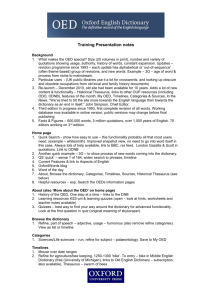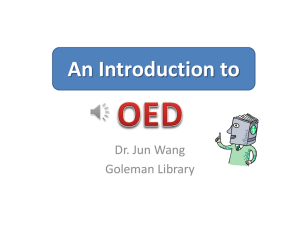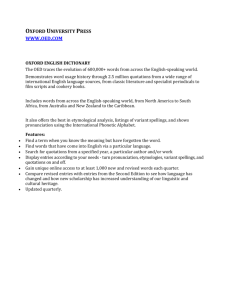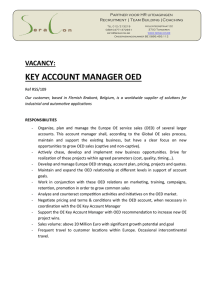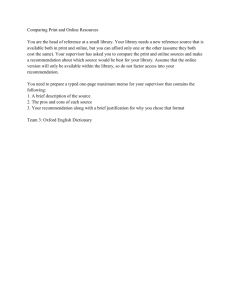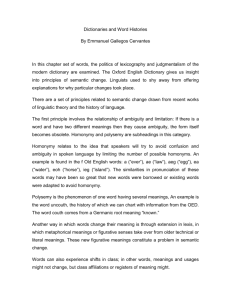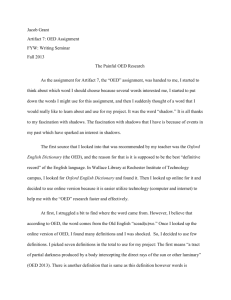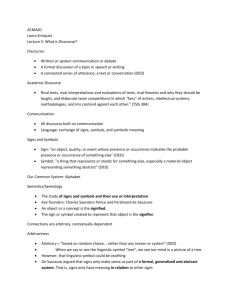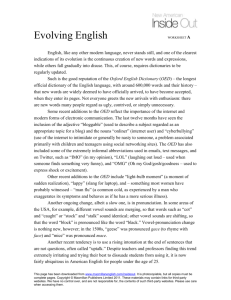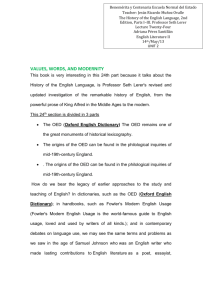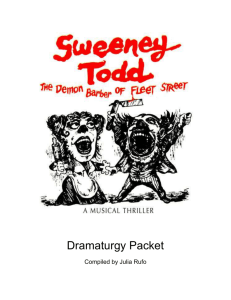Oxford Reference Online * Webex presentation (30 minutes)
advertisement
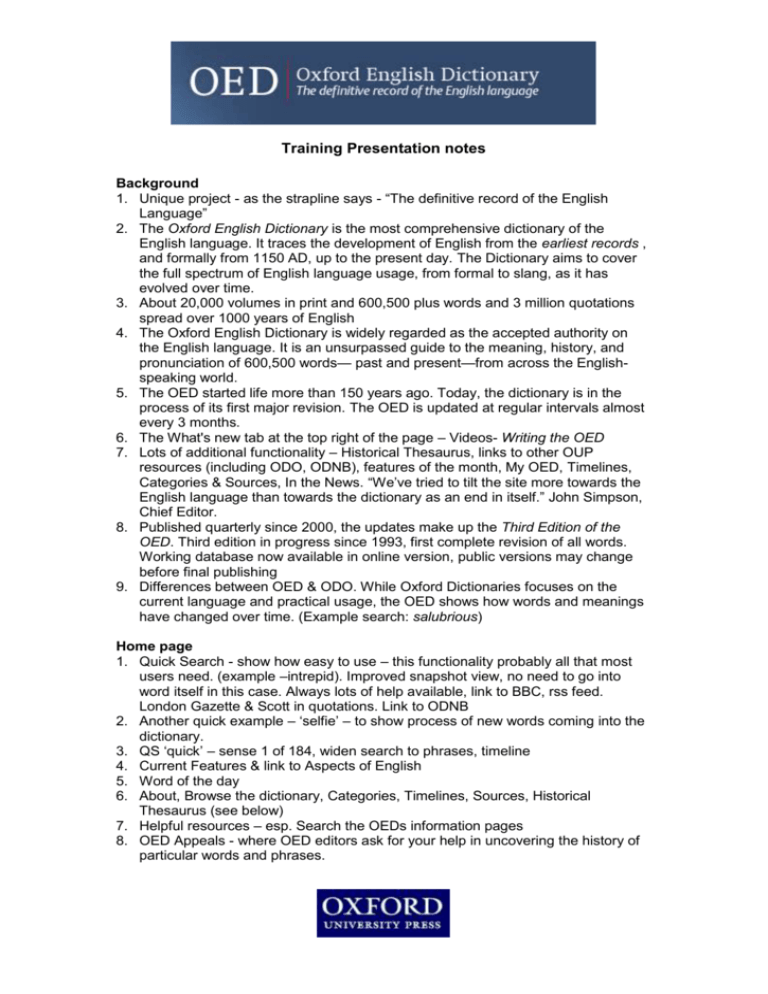
Training Presentation notes Background 1. Unique project - as the strapline says - “The definitive record of the English Language” 2. The Oxford English Dictionary is the most comprehensive dictionary of the English language. It traces the development of English from the earliest records , and formally from 1150 AD, up to the present day. The Dictionary aims to cover the full spectrum of English language usage, from formal to slang, as it has evolved over time. 3. About 20,000 volumes in print and 600,500 plus words and 3 million quotations spread over 1000 years of English 4. The Oxford English Dictionary is widely regarded as the accepted authority on the English language. It is an unsurpassed guide to the meaning, history, and pronunciation of 600,500 words— past and present—from across the Englishspeaking world. 5. The OED started life more than 150 years ago. Today, the dictionary is in the process of its first major revision. The OED is updated at regular intervals almost every 3 months. 6. The What's new tab at the top right of the page – Videos- Writing the OED 7. Lots of additional functionality – Historical Thesaurus, links to other OUP resources (including ODO, ODNB), features of the month, My OED, Timelines, Categories & Sources, In the News. “We’ve tried to tilt the site more towards the English language than towards the dictionary as an end in itself.” John Simpson, Chief Editor. 8. Published quarterly since 2000, the updates make up the Third Edition of the OED. Third edition in progress since 1993, first complete revision of all words. Working database now available in online version, public versions may change before final publishing 9. Differences between OED & ODO. While Oxford Dictionaries focuses on the current language and practical usage, the OED shows how words and meanings have changed over time. (Example search: salubrious) Home page 1. Quick Search - show how easy to use – this functionality probably all that most users need. (example –intrepid). Improved snapshot view, no need to go into word itself in this case. Always lots of help available, link to BBC, rss feed. London Gazette & Scott in quotations. Link to ODNB 2. Another quick example – ‘selfie’ – to show process of new words coming into the dictionary. 3. QS ‘quick’ – sense 1 of 184, widen search to phrases, timeline 4. Current Features & link to Aspects of English 5. Word of the day 6. About, Browse the dictionary, Categories, Timelines, Sources, Historical Thesaurus (see below) 7. Helpful resources – esp. Search the OEDs information pages 8. OED Appeals - where OED editors ask for your help in uncovering the history of particular words and phrases. Training Presentation notes About (also ‘More about the OED’ on home page) 1. History of the OED, One step at a time – links to the DNB 2. Learning resources KS3-uni & learning quizzes (open – look at hints, worksheets and teacher notes available) 3. Quizzes – best way to find your way around the dictionary for advanced functionality. Look at the first question in quiz (original meaning of skyscraper). Browse the dictionary 1. Refine, part of speech – adjective, usage – humorous (also remove refine categories). View as list or timeline Categories 1. Sciences/Life sciences – run, refine for subject – palaeontology. Save to My OED Timelines 1. Mouse over date ranges 2. Refine for agriculture/bee keeping, 1250-1300 ‘bike’. To entry – bike in Middle English Dictionary (free (University of Michigan), links to Old English Dictionary – subscription, also available), Thesaurus – swarm of bees 3. When Japanese influenced English Historical Thesaurus 1. ‘Semantic index to the contents of the OED’. Chronological within meaning. 66% coverage of words in OED, always being added to 2. 44-year project at the University of Glasgow. First printed 2009 – 2 volumes, 2nd volume is index – much easier to use online. Updated in tandem with OED. 3. Lots of interesting information about the project in the About section 4. External world/sensation/odours/fetor/stinking 5. Look up ‘fool’ in OED, then link to HT for other meanings, development. Scroll through historical list to ‘plonker’. Also, subcategories for female at the bottom of the list. Run search for ‘fool’ in HTOED for different categories. Also ‘drunk’. Sources See the most used sources. 1. Default view is total number of quotations. View Geoffrey Chaucer 2. Back to full list, reorder for dates. View Beowulf. Reorder dates for modern. View Guardian – podcasting (for discussion of what to call it) My OED 1. Saved entries & searches. Organise into folders. Preferences. Word entry 1. Skyscraper- oldest, original meaning at the top of definition, scroll down to modern meaning. Outline view – snapshot view of quotation dates. ODO link. Search ‘skyscrapper’ for alternative spellings. 2. Pronunciation – click for popup explanation Training Presentation notes 3. Print, save, email, cite Wildcard searches 1. *phobia, (list of 128), * can be used for spelling difficulties – rec*ship. OED brings up entry for receivership (& others) 2. ? for single letter (crossword – name of an animal, 6 letters z????y) ? for deciphering old documents with illegible characters. Advanced Search 1. First cited work – Ulysses, Subjects – engineering, French & textiles (crafts & trades), Language name - Basque 2. Combining search terms. Saucy Dance – list of 5, look also at ‘fricassee’ to see the toggle on/off for Quotations, and ‘egg’ to use the Control&F function to find the word in a long entry. Also ‘back’ ‘can’t (cannot) scratch 3. Slang words from the 1990s. 4. First quotation – Sterne, Joyce, Pynchon. Quotation - Kundera, Achebe, Vonnegut, M.Amis 5. Example – student of 18c. literature – usage ‘poetic and literary’ & dates of entry
